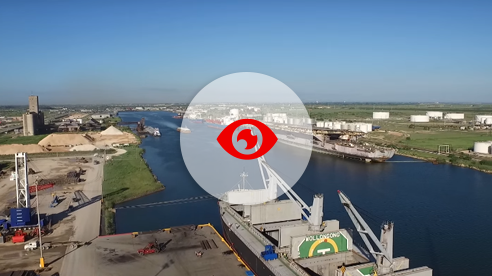The Port of Brownsville has been a driving force for the Rio Grande Valley’s economy with impacts reaching far across the Lone Star State. In the last decade, the port has made significant strides, bolstering its position as a crucial center for commerce and a catalyst for regional growth. With major infrastructure improvements, increased capabilities, and a strong commitment to sustainability, the Port of Brownsville is leading the way in the maritime industry and a symbol of progress.
Thanks to the port’s keen logistical network, the movement of waterborne cargo at the port has continued to rise. According to the. U.S. Army Corps of Engineers’ the port rocketed to 55th position out of 150 maritime ports nationwide for the movement of waterborne cargo in 2021, ahead of its 66th place in 2020.
The upward trend continues as more than 15.2 million tons of diverse cargo moved through the port in 2022, supporting various industries with efficient and reliable logistical services. This represents a 10.2 percent increase from the 13.8 million tons of cargo recorded in 2021, a new record for the Port of Brownsville. These growing numbers are reflected in the operating revenues as well. Notably, operating revenues for 2022 reached more than $38 million, surpassing the $30 million mark for the third consecutive year.
Robust revenues and sound fiscal stewardship have allowed the Brownsville Navigation District to invest in the port’s projected growth. In June, the port celebrated the groundbreaking of a 118-acre shovel-ready business park that caters to the growing demand for industrial developments in South Texas. The park will complement the port’s current efforts to create a diverse business hub, providing vital connections for companies to enhance market reach, supply chain efficiency, and build sustainable, resilient operations. The industrial park, suited for manufacturing and logistics operations, will be completed in Summer 2024.
The Port of Brownsville’s Foreign Trade Zone No. 62 remains a leader in exports, ranking second in the nation with exported goods valued at over $8.2 billion in 2022, according to the 84th Annual Report of the Foreign Trade Zones Board to the Congress of the United States. This marks a significant improvement from the previous year’s figure of $5.2 billion. The Port of Brownsville’s FTZ has consistently placed in the top three for exports out of 193 FTZs nationwide since 2012. Furthermore, FTZ No. 62 is ranked 20th in the United States for the value of imports, amounting to $5.7 billion.
On the Horizon
The Port of Brownsville continues to solidify its role as a critical asset and a key component of the Texas’ energy sector. In July, NextDecade Corporation announced it had received a positive final investment decision to move forward with the construction of its Rio Grande LNG plant, major liquefied natural gas export facility in the United States. The project aligns with the port’s objective to drive economic growth, and the benefits are expected to extend to the region, state, and country. Over 5,000 jobs are projected to be created in the area during Phase 1 of the construction of the facility, and this project is estimated to generate an increase in gross domestic product of $6 billion in Cameron County, $23 billion in Texas, and up to $35 billion in the United States.
Once fully operational, the Rio Grande LNG terminal will consist of five trains with the capacity to export 27 million tonnes per annum (MTPA). Phase 1, with nameplate liquefaction capacity of 17.6 MTPA, has already acquired 16.2 MTPA of long-term binding LNG sale and purchase agreements with TotalEnergies, Shell NA LNG LLC, ENN LNG Pte Ltd, Engie S.A., ExxonMobil LNG Asia Pacific, Guangdong Energy Group, China Gas Hongda Energy Trading Co., Galp Trading S.A. and Itochu Corporation. The total project’s financing for Phase 1 is $18.4 billion.
Infrastructure improvements at the port continue with the Brazos Island Harbor (BIH) Channel Improvement Project, which will deepen the 17-mile-long ship channel from 42 to 52 feet. A deeper ship channel will increase the navigability, facilitating the safe passage of ships and reducing transit times. These infrastructure upgrades will significantly boost the Port’s competitiveness and attract increased investments.
The BIH project, comprised of two phases, is funded through the U.S. Army Corps of Engineers’ (USACE) Public-Private Partnership (P3) with the Port of Brownsville and NextDecade.
In 2019, NextDecade announced a landmark agreement with the Brownsville Navigation District to pay 100 percent of Phase 1 of the deepening project from the western boundary of its lease site along the ship channel to the entrance of the channel, as well as the development of two ship berths and a turning basin for the Rio Grande LNG facility. The Port of Brownsville and the USACE will execute Phase 2, which will deepen the channel from the turning basin area to Rio Grande LNG’s site. In March 2022, the federal government announced the allocation of $68 million for Phase 2, provided under the Infrastructure Investment and Jobs Act Appropriations Law. Phase 2 of the project commenced in February.
The Port of Brownsville remains a leader in the movement of wind energy components, thanks to its logistical capabilities and strategic location along the U.S.-Mexico border.
During the first quarter of 2023, five vessels exported wind project cargo to South America, moving more than 80 windmill blades. The blades, manufactured locally by TPI Composites at its facility in Matamoros, Mexico, were transported to the port by truck via the Free Trade International Bridge at Los Indios and securely loaded on to vessels destined for Brazil, Chile, Colombia and Peru.
As the largest land-owning port in the U.S., the Port of Brownsville tops the nation for its capability of receiving, storing and moving massive components for the wind energy industry, including the largest windmill blades imported to the U.S. The port’s specialized equipment and skilled workforce are experienced in handling the oversize windmill components for transport by vessel, barge, rail, and truck with ease.
Adapting to changing market dynamics and embracing innovation, the Port of Brownsville plays a pivotal role in driving economic growth, creating employment opportunities, and strengthening its position as a critical trade gateway for the United States.

In the 2021 annual report by the U.S. Army Corps of Engineers, the Port of Brownsville ranks 55th out of 150 maritime ports nationwide for the movement of waterborne cargo.








